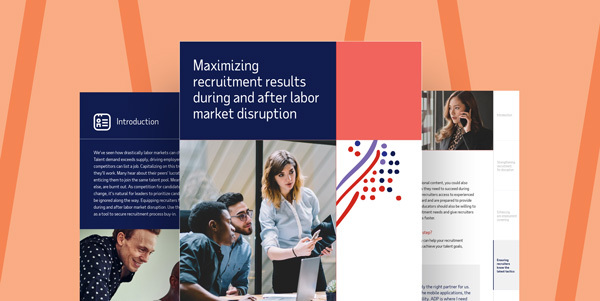Voluntary employee departures from the workplace, especially those that come as a surprise to an employer, can result in workplace difficulties. What’s worse, employees who are dismissed quickly may feel emotional and share their uncomfortable experiences online where potential customers and current and future employees can see it. Such negative publicity may adversely affect brand image, talent acquisition and employee retention.
That’s why it’s important for employers to have a strategic offboarding program. It not only helps departing employees leave on a positive note, but by collecting honest feedback, it can also reveal opportunities for workplace improvements.
Table of Contents
What is offboarding?
Offboarding is how employers part ways with employees. The process may include an exit interview with two primary objectives:
- Maintain cordial rapport with departing employees
- Discover insights that support positive organizational change
Offboarding vs. onboarding
Onboarding and offboarding are opposite processes. During onboarding, new hires learn about company policies, workplace culture and their role in the organization’s future. Offboarding, in contrast, involves preparing employees for their departure. At this stage, employees may share institutional knowledge with successors, turn in employer-supplied tools and equipment, and provide feedback about their employment experience.
Why is offboarding important?
Employers may prioritize recruitment and onboarding over offboarding, but offboarding is also important in the employee lifecycle. For example, an underdeveloped offboarding process may be a missed opportunity to learn what makes employees want to stay or leave an organization. Without these insights, it may be more difficult to improve employee engagement and retention or talent acquisition.
Aside from data, departing employees may influence an employer’s recruiting efforts in other ways. There are various digital career sites where employees can share their experiences, which may impact public opinion of an organization. Former employees may also resurface as ideal candidates for future positions or consulting opportunities.
Offboarding best practices
Writing off employees who turn in their notice or rushing their exit may be a mistake. A more effective approach is to be respectful of the employee’s experience and expertise and ease the transition so in the end, they can become brand ambassadors. Such an offboarding process may follow these steps:
- Organize departure requirements
Taking a moment to organize all the requirements of an employee’s departure can help ensure no steps are missed. Where applicable, employers may be required to: - Provide 401(k) plan, health and life benefits information
- Arrange for the safe return of business property
- Cancel permissions (email addresses, system access, etc.)
- Verify up-to-date contact information for the employee
- Communicate any applicable severance package information
- Address employees’ personal needs
A good way to manage personal needs is to schedule a meeting with benefits personnel so they can resolve any outstanding payroll and benefits issues promptly. Common priorities for departing employees are managing unused paid time off (PTO), health coverage continuation (COBRA), and options for continuing or transitioning savings accounts, i.e., retirement plans, flexible spending accounts, health savings accounts, etc. - Coordinate the transition
Offboarding should also include a meeting to discuss current projects and assignments, as well as relevant files, contacts and resources. This step helps ensure that work can continue as usual once the employee leaves the workplace. If the transition goes smoothly, it may also help departing workers feel valued during their last days with the organization. - Celebrate the employee
Many employers organize a lunch or other event where team members can bid farewell to a colleague and share good memories of working together. These gatherings may help the departing employee leave with positive feelings toward the organization. - Transfer knowledge
Employers may wish to coordinate formal apprenticeships and team-based training exercises to acquire knowledge from departing employees before they leave the organization. This step is critical for senior-level employees with years of institutional knowledge. - Reduce technical risks
Employers should also take appropriate steps to protect their business operations and trade secrets by discontinuing workstations and cloud access, changing email logins, and retrieving employer-issued devices. Risks to the business may be higher if the departure from a former employer is not the product of a mutual decision or if the employee is going to a competitor. - Conduct an exit interview
With a departing employee, employers have an opportunity to find out how their people feel about management, the workplace culture and more. Exit interviews and surveys may provide a wealth of information, especially when departing workers are candid about any long-held frustrations or beliefs they may have had. - Finalize the departure
Employees should know how to remove all personal items from their workstations and return company-owned equipment. If a security escort is necessary on the final day, it may be a good idea to have a colleague or supervisor join so employees don’t feel like they are being kicked out of the building. - Keep in touch with the former employee
Although it may not be appropriate in all situations, maintaining a connection with former employees may prove valuable. They may continue to advocate for the brand and provide employee and customer referrals or may even return to the organization in another role someday.
What to look for during an exit interview
To uncover actionable insights at the organizational, department or team level, exit interviews should focus on the topics essential to employee engagement, such as:
- Quality of relationship with direct managers
- Trust in senior management
- Satisfaction with organizational culture
- Opportunities for advancement
- Compensation and benefits offered
How to make the most of exit interviews
It may be difficult to obtain honest answers from employees during an exit interview. They may experience forgetfulness, feel embarrassed or have concerns about burning bridges. To overcome these challenges and get insightful feedback that inspires real change, consider these tips:
- Choose the interviewer carefully
Find a designated HR representative or a manager from another team to conduct the exit interview. Departing employees may be more forthcoming with someone they don’t interact with daily. - Give the departing employee time to prepare
Provide exiting employees with at least two to three days’ notice of their exit interview so they can reflect upon their time with the organization and take notes about any key issues they plan on addressing. - Protect communications
Elicit more genuine responses by clarifying that employee feedback will only be shared as needed for business reasons. This step should be easy for employers who have already established a culture that encourages honest and open communication. - Accept electronic feedback
Allow employees to complete an online survey or answer questions via email. Despite an employer’s best efforts, individuals who are nervous or shy may still feel intimidated by a face-to-face exit interview. - Act on the results
If areas for improvement are identified during an exit interview, act accordingly. Doing so may send a message to existing employees that their voices matter and that the organization is always seeking new ways to enhance the workplace.
Frequently asked questions about offboarding
Why should HR leaders care about offboarding?
Employees who voluntarily separate from their employer and are met with disrespect or hostility may publicly share negative reviews about the organization. Therefore, if employers care about retaining employees, attracting new talent and preserving their reputation, they should take offboarding seriously.
What can HR do to ensure successful offboarding?
Successful offboarding may turn departing employees into brand ambassadors for their former employer. Among other steps to achieve this goal, employers should make the transition process as smooth as possible and let exiting employees know that their feedback is valued.
How can smooth offboarding processes improve company culture?
How a business treats its employees, whether they are at the beginning or end of their tenure, speaks volumes about the organization, its leaders and its culture. Being respectful of departing employees may help turn a challenging situation into a positive outcome.
What is one of the key parts of a successful offboarding?
Exit interviews allow employers to learn about improvement opportunities and potentially retain current employees. Say, for example, a significant number of departing employees report that discrepancies between initial job descriptions and their actual duties are their reason for leaving. The employer then knows to set more explicit performance expectations from the start of employment.
Who is responsible for employee offboarding?
HR representatives and supervisors may be actively involved in the offboarding process. In some cases, however, someone other than the departing employee’s manager may be better suited to conduct the exit interview so employees feel more comfortable and provide forthcoming answers.
This article is intended to be used as a starting point in analyzing the offboarding definition and is not a comprehensive resource of requirements. It offers practical information concerning the subject matter and is provided with the understanding that ADP is not rendering legal or tax advice or other professional services.





